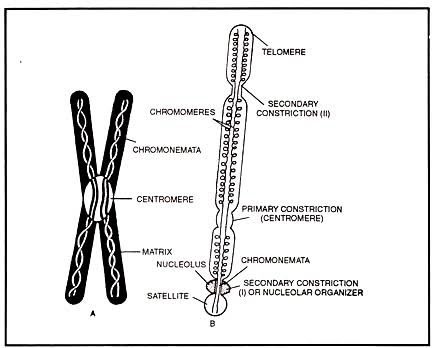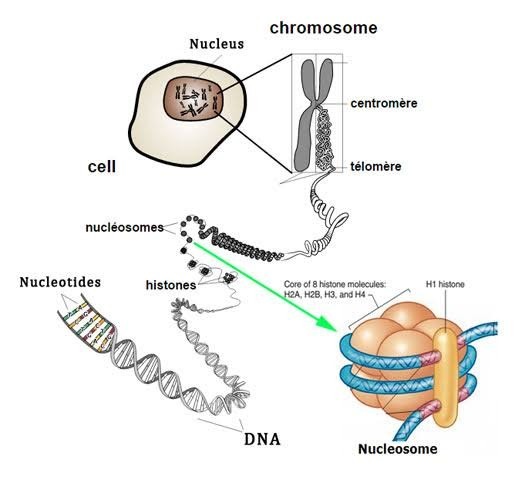Chromosomes: Structure and Organization
What is Chromosomes?
- Chromosome is a microscopic thread like structure.
- It is a part of cell that carry hereditary information in the form of genes.
- Chromosome are the rod shape, dark stained bodies which is seen only at metaphase stage of mitosis.
- Strausberger in 1875 was first to describe chromosome and word chromosome was given by Waldeyer in 1888.
Chromosome number and size
- Each species has a somatic and gametic chromosome number.
- Somatic chromosome number is the number of chromosomes present in somatic cells and it is shown by 2n.
- Gametic chromosomes number is the number of chromosomes present in gametic cells of an organism. It is shown by n and is precisely one half of the somatic number.
- Homologous chromosomes is defined as the two copies of a chromosome, which is identical in morphology, gene order, and gene content.
- The size of chromosomes, depends on the different stages of the cell division.
- During interphase, chromosomes are not visible under light microscope because at this stage they are longest and thinnest, but in other phase chromosomes are visible due to progressive decrease in length and increase in thickness.
Morphology
- Morphology of chromosomes will be change at the stage of cell division, and metaphase chromosomes are foremost suitable for studies.

The following structural features are seen under the microscope, in metaphase chromosome:
-
- Chromatid
- Centromere
- Telomere
- Secondary constriction and satellite chromosomes.
- Chromomere (seen during prophage).
Chromatid
- Each metaphase chromosome is divides into two identical parts (longitudinally) each of which are referred as chromatid.
- Chromatid is that the structural and functional unit of chromosomes and its not further subdivided into smaller units.
- Sister chromatids: The two chromatids building up a chromosomes are developed by replication of a one chromatid.
- The chromatids of homologous chromosomes are called non- sister chromatids.
Centromere
- Centromere is a region where the two chromatids of a chromosome seems to be joined or fused.
- Under microscope, centromere generally appears as constriction (a narrowed region) in the chromosome, hence it is Known as Primary Constriction.
- Each chromosome are splits into two transverse parts by its centromere: these parts are known as Arms.
- In most cases, one arm of the chromosomes is longer than the other, hence they’re termed as Long arm and short arm, respectively.
- Long is represented by q while short arm usually denoted by p.
On the basis of position of their centromere, chromosome is of 4 types:
-
- Metacentric chromosomes
- Submetacentric chromosome
- Acrocentric chromosome
- Telocentric chromosome
Metacentric chromosome
- Centromere is found at the center of chromosome.
- Centromere is median.
- Two arms of such chromosomes are equal and ARM ratio is 1.
- Such chromosomes appear V-shaped, during anaphase.
Submetacentric chromosome
- Centromere is submedian and located on one side of the central point.
- Chromosomes appear either like ‘V’ or ‘J’ shaped, during anaphase.
Acrocentric chromosome
- They are subterminal.
- Centromere are located near one end of the chromosome.
- Chromosomes may appear either like ‘J’ or rod-shaped, during anaphase.
Telocentric chromosome
- Centromere located at one end of chromosomes.
- Such chromosomes are called terminal.
- They always appear as rod- Shaped, during anaphase.
Monocentric chromosome: chromosomes in most species features a single centromere.
Polycentric chromosome: Each chromosomes has more than one centromere.
Telomere

- The two ends of a chromosomes are known as telomere.
Secondary constriction or satellite chromosome
- In some chromosomes, is second constriction, is present additionally to the primary constriction, this extra constriction called, secondary constriction.
- The region between the secondary constriction and the nearest telomere, is known as satellite.
- Chromosomes having secondary construction are called, satellite chromosomes or sat-chromosome.
Chromomere
In some species E.g. maize, amphibia etc. chromosomes during the first prophase of meiosis, more particularly during pachytene, show small bead like structure called chromomere.
Chromatin
- It is material of which chromosomes are composed.
- Chromatin are classified into two groups, on the premise of stainability with basic dye:
-
- Heterochromatin
- Euchromatin
Heterochromatin
- Take deep stain during prophase and interphase.
- Lightly stained, during metaphase.
Euchromatin
- Takes up little stain during interphase, stains lightly during prophase.
- Stained deeply, during metaphase.
Heterochromatin is divided into two groups:
- Constitutive
- Facultative
Constitutive heterochromatin
- Remains permanently within the heterochromatic state.
- It doesn’t revert back to the Euchromatin State. E.g. – centromeric region.
Facultative heterochromatin
- Euchromatin undergoes hetero chromatinization (conversion into heterochromatin).
Chemical composition
- Chromatin is consisting of DNA, RNA and Protein.
- Chromatin isolated from interphase nuclei contain:
-
- 30-40% – DNA
- 50-65% – Protein
- 0.5-10% – RNA
- Metaphase chromosomes contain:
-
- 15-20% – DNA
- 10-15% – RNA
- 65-70% – Protein
Organization of chromatin fiber (nucleosome solenoid model)
- Both metaphase chromosome and of interphase nuclei show fibers of 200-300 A°: these fibers are called chromatin fibers.
- Chromatin fibers are the basic and essential unit of chromosome structure.
- The nucleosome solenoid model of chromatin fiber is universally accepted.
- This model was developed by Kornberg and Thomas in 1974.
- According to this model, chromatin is consisting of a repeating unit called Nucleosome.
- One complete nucleosome, a whole disc of 11nm diameter and 6nm height.
- Nucleosome contain an average of ~200bp DNA which usually ranges between 180 and 200bp.
Nucleosomes consists of:

Nucleosome core
- It consists of histone octamer, composed of two molecules each of histones H2a, H2b, H3 and H4.
- In addition, a 146 bp long DNA molecules is wound round this histone octamer in 1-3/4 turns.
- This segment of DNA in chromatin fibers is nucleus resistant.

Linker DNA
- The size of linker DNA vary from 8 bp to 114 bp depending on the species.
- This DNA forms the string a part of the heads on a string structure seen on isolation of chromatin fiber, and is nuclease susceptible.
H1 histone
- Each nucleosome consists of an average one molecule of H1 histone.
- Complete removal of H1 histone doesn’t affect the structure of nucleosome core, showing that H1 is found outside the nucleosome core.
Other chromosomal proteins
- Both linker DNA nucleosome are related with other chromosomal protein.
- In native chromatin, the beads are about 110A° in diameter is 60A° high and ellipsoidal in shape.
- The nucleosome stacked together without any detectable linker DNA between, this produces the 100A° thick chromatin fiber called nucleosome fiber.
- The Nucleosome fiber is also called 10 nm fiber.
- The nucleosome fiber may then supercoil to give rise to the 300A° chromatin fiber seen in electron micrographs of metaphase chromosome.
- The supercoiled nucleosome fiber is called 30nm fiber, which most likely has solenoid organisation of nucleosome.
Reference and Sources
- 1% – https://onlinesciencenotes.com/chromosomes/
- 1% – http://www.authorstream.com/Presentation/suvarna118329-2237733-special-type-chro
mosome/ - 1% – https://www.yourarticlelibrary.com/biology/physical-basis-of-life-chromosome-appearance-morphology/41736
- 1% – https://www.thoughtco.com/diploid-cell-373464
- 1% – https://www.biologydiscussion.com/chromosomes/chromosomes-introduction-number-and-types-cell-biology/26817
- 3% – https://www.yourarticlelibrary.com/biology/chromosomes-structure-functions-and-other-details-about-chromosomes/22946
- 1% – https://www.slideshare.net/AashishPatel14/chromosome-and-its-structure
- 1% – https://www.biologydiscussion.com/chromosomes/chromosomes-in-the-nucleoplasm/36998
- 1% – https://www.slideshare.net/tvr329/chromosome-structure-function
Also Read:
- Vector: properties, types and characteristics
- What is Gene Expression?
- DNA replication in prokaryotes
- Mutations: Introduction, Types, Causes and Repair Mechanisms
- Microorganisms in Benthic Marine Environments
- Probiotics: Introduction, Development and Uses in Agriculture
- Major histocompatibility complex (MHC): introduction, types and differences
- DNA Replication in eukaryotes: Initiation, Elongation and termination
- Hansen’s Disease: Symptoms, Causative Agent, Pathogenesis and Treatment
- CRISPR-Cas9 Gene editing tool: Introduction, Principles, Uses & Applications
- Microbial Identification and Strain Typing Using Molecular Techniques
- Reverse Transcription Polymerase Chain Reaction (RT-PCR)
- Microbiology Disciplines: Bacteria, Viruses, Fungi, Archaea and Protists
- Fungi: Distribution, Morphology, Reproduction, Classification

I liked these concepts very much, it’s easily to understand and easy to learn
thank you ankita keep supporting us
How to download them as pdf
Thank you so much mam ,
It’s remembered me, when i was high school. I liked it.
Thank you so much, keep supporting us